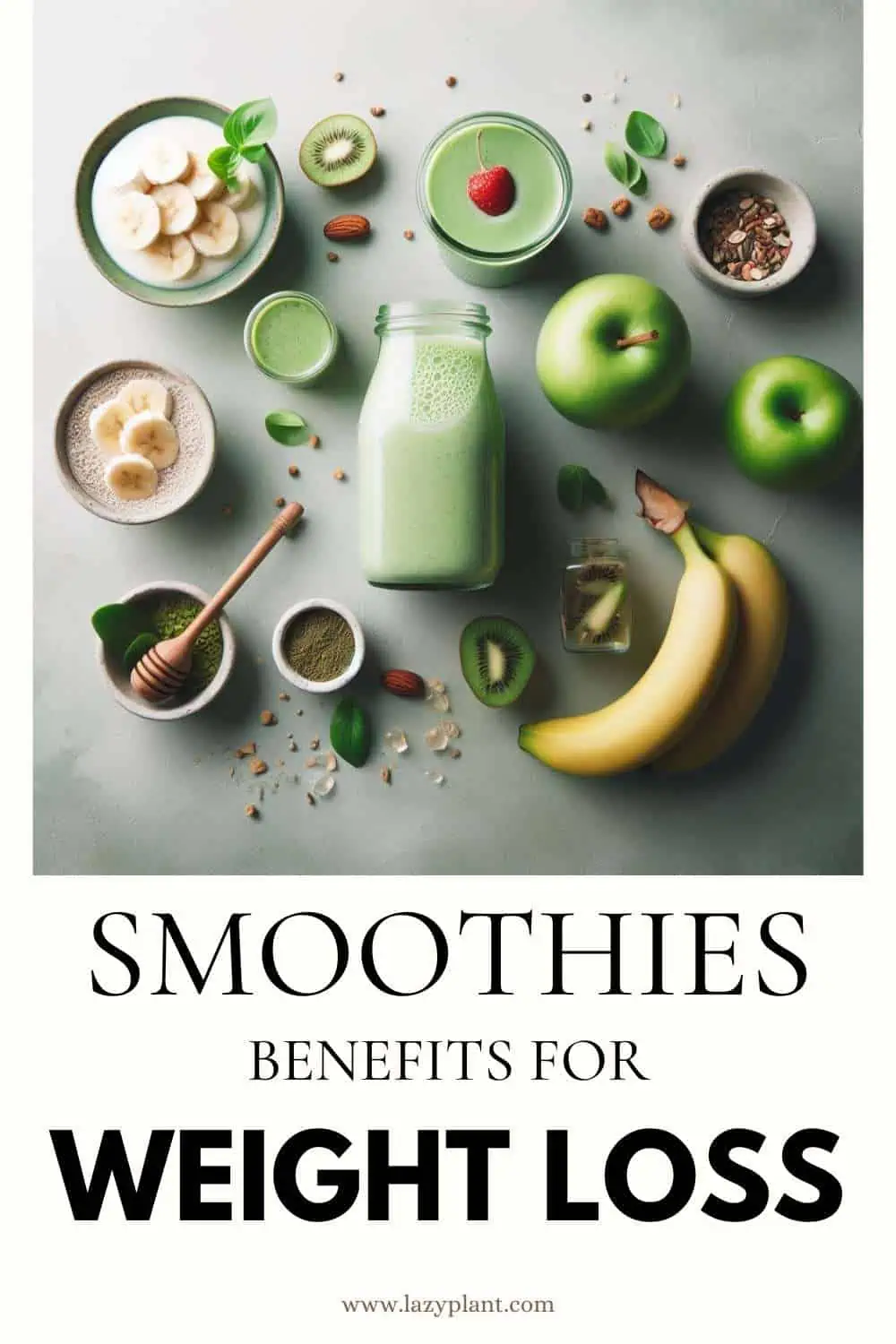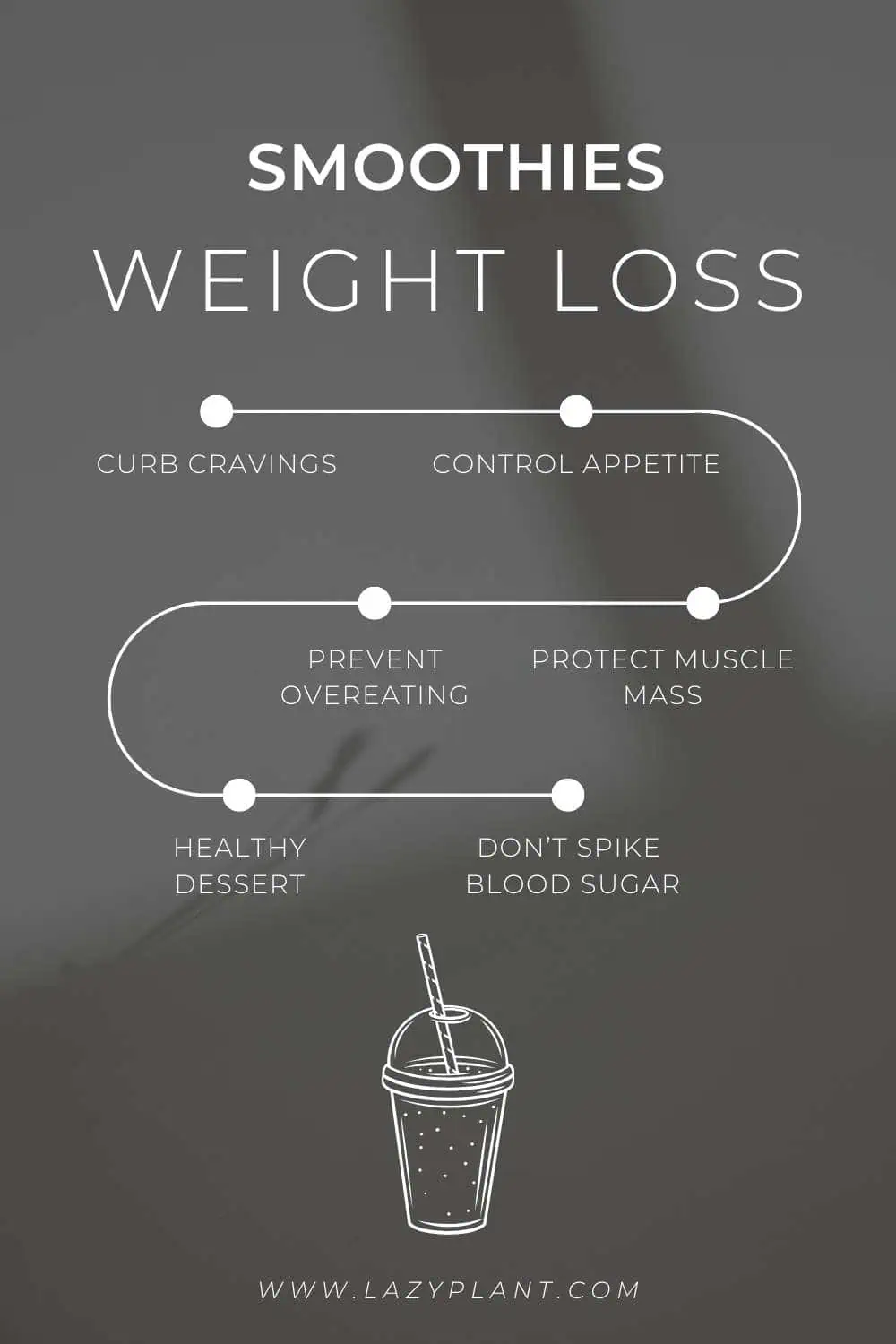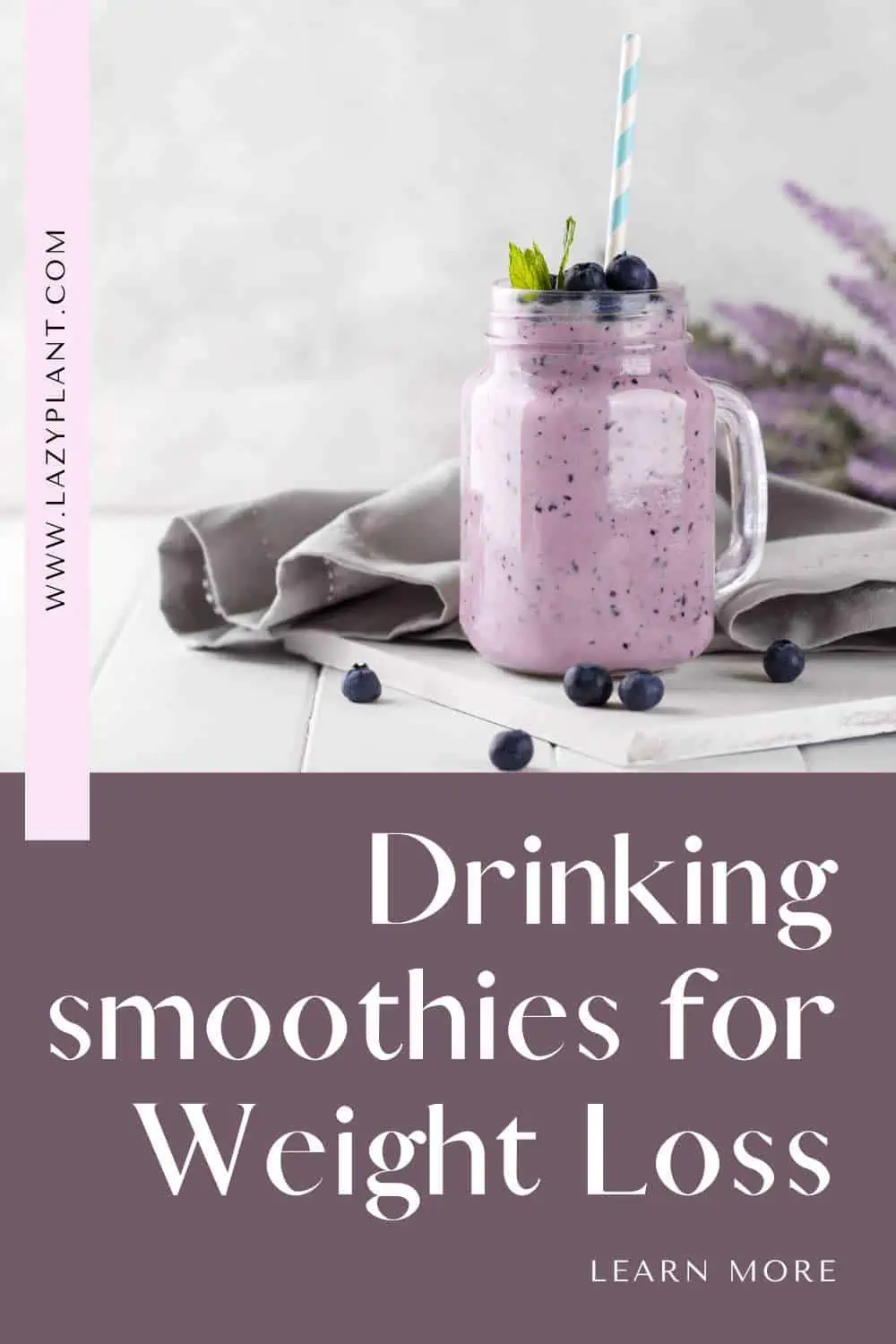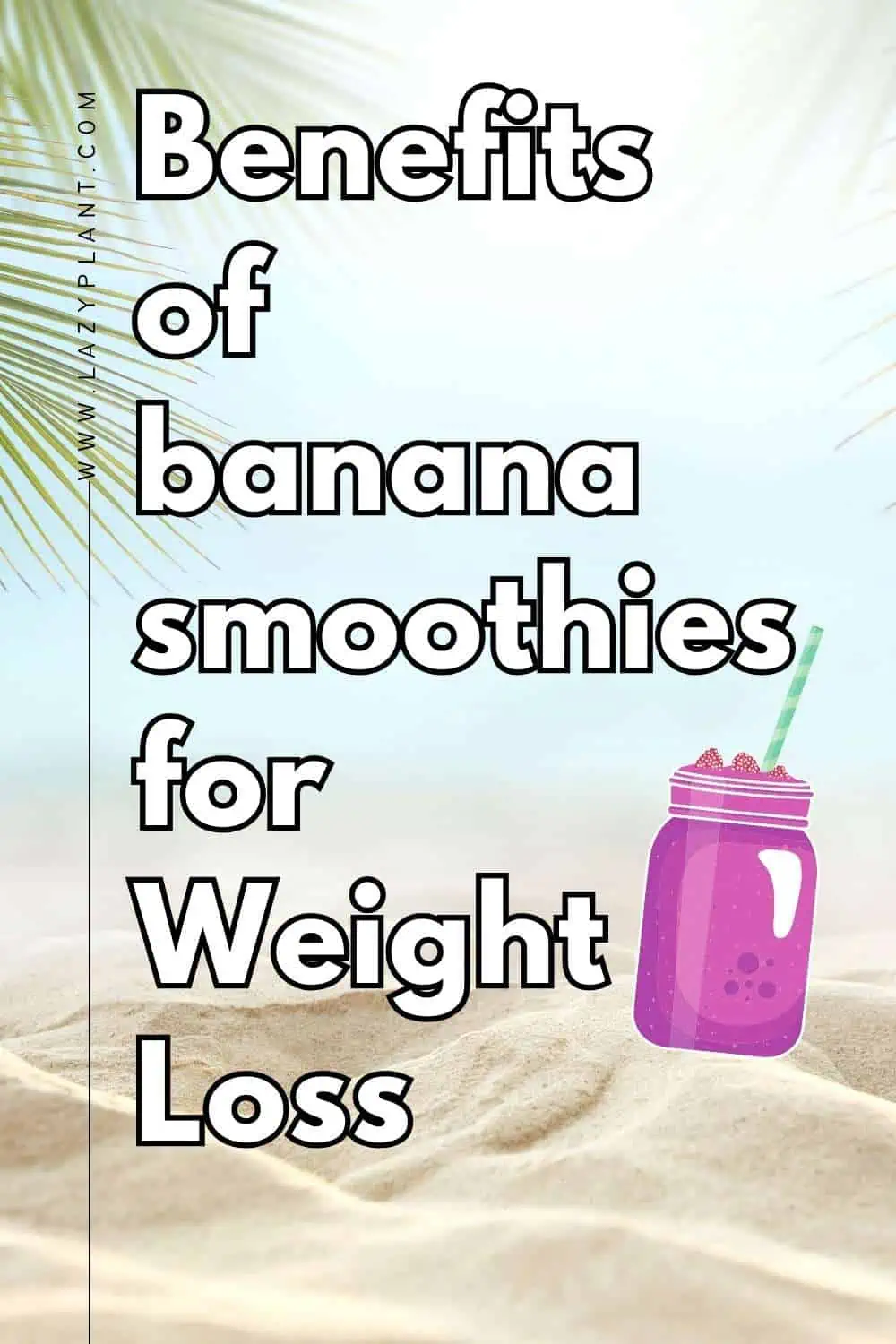Banana smoothie supports weight loss, as it’s packed with fiber, vitamins, minerals, antioxidants, and health-promoting phytochemicals that burn fat, increase metabolism, and regulate appetite!
Is banana smoothie healthy?
Banana smoothie is very healthy. It’s the easiest way to nourish the body with vitamins, minerals, fiber, antioxidants, and many other health-promoting phytochemicals, which most people on a typical Western diet don’t get.
For instance, bananas are among the healthiest foods you can daily eat for weight loss, as they’re excellent dietary sources of fiber, magnesium, potassium, and even vitamin C. Moreover, bananas contain traces of many other minerals and vitamins, like calcium and iron!
Adding fruits and green leafy greens could further boost the vitamin, mineral, and antioxidant content of a banana smoothie! Actually, green leafy greens and herbs are the most nutrient-dense foods.
A smoothie can be the healthiest meal of the day. Also, it’s pretty convenient and easy to prepare.
How many calories are in a glass of banana smoothie?
Banana smoothies are good for weight loss, but only if they’re low in calories. A caloric deficit is key for weight loss. We lose weight only when we consume fewer calories than we burn.
Therefore, try to prepare banana smoothies with fewer than 200 calories. Only athletes or people who consume more than 2,000 calories a day can drink banana smoothies with more calories and still lose weight!
Mistakes that make you gain weight
Banana smoothies with less than 3–4 ingredients tend to have the fewest calories. It’s a common mistake to add too many ingredients, loading banana smoothies with many unnecessary calories, fats, and sugars.
First, a banana has between 90 and 135 calories, depending on the size and the ripeness stage. Keep in mind that overripe bananas are much richer in sugar than green bananas.[1]
Fats
Other fattening foods that are common ingredients in smoothies are peanut butter, cow’s milk, seeds, and nuts. There is no reason to avoid them altogether. You should mind the portion sizes, though.
Fruits & Juices
Furthermore, avoid adding fruit juices, if you want to limit the calorie content of the smoothie. Even homemade fresh-squeezed fruit juices are particularly high in sugars and calories.
Prefer whole fruits instead. Whole fruits don’t spike blood sugar as much as fruit juices because they’re pretty rich in fiber., which controls glucose responses and appetite! If your banana smoothie lacks fiber, you might feel hungry sooner and end up consuming more calories throughout the day.
While fruits offer vitamins and fiber, they also contain natural sugars. Using too many fruits in your smoothie can significantly increase its calorie content. Instead, opt for one banana alongside vegetables, leafy greens, or low-sugar fruits like berries.

Sweeteners
Adding additional sweeteners (such as honey, agave syrup, or sugar) to your banana smoothie can significantly increase its calorie content. Opt for natural sweetness from the fruit itself and avoid unnecessary extras.
Protein
Protein helps keep you full and supports muscle health. If your smoothie lacks protein, you might find yourself reaching for additional snacks shortly after drinking it.
Smoothies are a healthy snack, but they shouldn’t replace balanced meals. Ensure you’re practicing healthy eating habits throughout the day, not relying solely on smoothies for nutrition.
The role of Fiber
Above all, banana smoothies are good for weight loss because they help us meet our daily fiber needs. Fiber controls appetite and decreases cravings for fattening foods.
For instance, a smoothie with a medium banana, 2 leaves of kale, and 1 tbsp of ground flaxseeds, blended with almond milk contains about 6 grams of fiber or 22% of the Daily Value.
Moreover, high fiber intakes have been associated with a lower risk of developing heart disease, stroke, hypertension, diabetes, obesity, and certain gastrointestinal diseases. Also, fiber may reduce high blood pressure and serum cholesterol levels, enhance immune functions, and improve insulin sensitivity.[2]
Minerals in seeds & nuts support weight loss
Moreover, you could add a tbsp of seeds and nuts to your favorite smoothie. They have a great nutritional value. They’re particularly high in minerals, which are important for a good metabolism.
Don’t add too many, though. They’re pretty high in calories.
Seeds and nuts are among the best dietary sources of magnesium, calcium, potassium, copper, selenium, and many more minerals.
Magnesium
High magnesium intakes are beneficial for obese individuals or people with insulin resistance. Magnesium can help them lose weight, and reduce waist circumference, and Body Mass Index.[3,4]
Obese people and people with diabetes tend to have low levels of magnesium. Magnesium deficiency may lead to many health problems, such as hypertension, and cardiovascular, and metabolic disease.[5,6]
Pumpkin seeds, chia seeds, and flaxseeds are the richest foods in magnesium.
Potassium
A diet high in potassium promotes weight loss. It reduces waist circumference, Body Mass Index, inflammations, and insulin resistance! Hemp seeds, sunflower seeds, chia seeds, and pumpkin seeds are among the richest foods in potassium.
Calcium
High calcium intake may be beneficial for weight maintenance as well as weight loss.[7]
Calcium may prevent hunger and reduce insulin resistance. It can help people stick to a long-term calorie-restrictive diet. Moreover, high calcium intake can improve body composition. Calcium helps maintain lean mass.[8,9]
People in a caloric deficit need more calcium. Their bone mass may be reduced, otherwise.[10]
Cow’s milk and dairy aren’t the only good dietary sources of calcium. Seeds, and greens, like kale and spinach, are also excellent plant-based sources of calcium. For instance, chia seeds are the richest common food in calcium, containing 631 mg per 100g!

Seeds and nuts are also great sources of copper and selenium.
- Copper plays a key role in the metabolism of carbs, protein, and fats.
- Selenium may improve insulin sensitivity, increase energy levels, and improve mood, helping us follow a long-term energy-restricted diet.
Omega-3s
Moreover, chia seeds and ground flaxseeds are the richest common plant-based foods in omega-3s! Omega-3s have so many health benefits. In addition, they may reduce body weight and fat mass.[11]
Omega-3s may help curb hunger and reduce appetite, which is particularly beneficial for those following weight loss diets. When you feel less hungry, you’re less likely to overeat or snack excessively.
Also, they may improve how your body uses insulin, leading to better blood sugar control and potentially reduced fat storage.
Chronic inflammation is linked to obesity and insulin resistance. Omega-3s’ anti-inflammatory properties could indirectly aid weight management.
Keep in mind that omega-3s alone won’t guarantee weight loss. They should be part of a balanced diet and regular physical activity for optimal results.
The importance of adding Protein sources
Smoothies should be rich in protein. Protein is necessary for maintaining muscle mass. Increased muscle mass leads to a higher metabolism.
Also, protein keeps us full for a long time. Actually, foods rich in protein, fiber, and water are more satiating.[12]
Furthermore, protein has the highest thermic effect. We burn 20 to 30% of protein calories during digestion.[13]
Excellent sources of protein are cow’s milk, Greek yogurt, and of course, whey powder.
You could really boost the protein content of a smoothie, by adding a scoop of protein powder. You can find a wide variety of high-quality plant-based or whey protein powders on iHerb.
Animal-derived foods have high-quality protein. It’s highly bioavailable and contains all essential amino acids. However, you can get high amounts of protein from plant-based smoothies as well.
People looking to lose weight could benefit from increasing their daily protein intake.
Vegan banana smoothie
Banana smoothies without yogurt or cow’s milk are also good for weight loss.
You could replenish cow’s milk with any plant-based milk. Try almond, oat, or rice milk. But, soy milk is the best plant-based alternative. First, it has the richest protein content among plant-based milks. In addition, soy milk is particularly rich in calcium and iron!
Also, soy milk is great for weight loss, as it has fewer calories than cow’s milk. Moreover, soy milk is the richest food in isoflavones! These phytochemicals are powerful antioxidant compounds with countless health benefits!
You can find a wide variety of plant-based milks on Amazon.
Greens are also excellent sources of protein. Broccoli, kale and spinach are particularly rich in protein. They can help you meet your daily needs.
Furthermore, spinach is among the richest common foods in GABA. GABA is a key chemical for maintaining a lean body. It promotes muscle growth and helps the body burn more belly fat, as it may naturally increase Human Growth Hormone levels and metabolism!
What’s the best time to drink a banana smoothie?
Experiment and see when you feel most energized and satisfied after having a smoothie.
At breakfast
Drinking a banana smoothie as your breakfast can kickstart your day with essential nutrients. It provides sustained energy and helps prevent mid-morning hunger cravings.
Above all, green smoothies are packed with antioxidant compounds, which protect us from oxidative stress. It’s always better to boost the antioxidant capacity of the body during the daytime.
Antioxidants protect us from the detrimental effects of air pollution, sunlight radiation, and smoking. These are common risk factors that contribute to the excessive production of free radicals and eventually to oxidative stress.[14,15,16]
Also. smoothie is a quick and convenient snack. You can prepare and drink it in a couple of minutes.
After exercise
Consider having your banana smoothie right after your workout. It replenishes glycogen stores, aids muscle recovery, and provides a natural energy boost.
As the body has improved insulin sensitivity, you can add your favorite sweeteners to your post-workout smoothie. After strenuous exercise, the body demands extra sugar to replenish lost muscle glycogen.
Prefer, a protein-packed banana smoothie after a workout to help you recover faster!
Afternoon snack
Smoothies can be a satisfying snack to curb cravings and prevent overeating before dinner. Choose ingredients low in sugar and high in fiber for sustained satiety.

Before a high-calorie meal
Some recommend drinking a banana smoothie about 1-11/2 hours before your main meal. This can help control appetite and prevent overeating during a calorie-dense meal.
Can I drink a banana smoothie at night for weight loss?
A smoothie can be a healthier option compared to ice cream, candy, or other calorie-dense desserts.
You can add protein powder or Greek yogurt to your smoothie for satiety and to potentially prevent nighttime cravings.
However, even healthy smoothies can have many calories. Consuming excess calories, especially from sugar, at night, can hinder weight loss. Actually, better to avoid consuming carbohydrate-rich foods right before bedtime, as the body has increased insulin resistance late at night.
Moreover, some people find sugary or heavy meals close to bedtime disrupt their sleep quality. If nighttime smoothies disrupt your sleep or digestion, consider them as a daytime snack instead.
What’s the worst time of the day to drink a banana smoothie?
The worst time of the day to drink a smoothie is right before exercise. It takes time to digest a smoothie. Working out with a full stomach will probably lead to bloating, gas, discomfort, or stomach cramps. As a rule of thumb, avoid eating fiber at least a couple of hours before strenuous exercise.
Focus on consuming a variety of nutritious foods throughout the day, not just relying on smoothies for weight loss.
Green or ripe bananas for a creamy smoothie?
For a creamy smoothie that supports weight loss, ripe bananas are the way to go!
Ripe bananas are softer and sweeter than green ones. Their natural sweetness adds flavor to your smoothie without the need for additional sweeteners.
Ripe bananas are easier to digest, making them gentle on your stomach. This is especially important if you’re having a smoothie as a meal replacement or snack.
Ripe bananas blend into a creamy consistency, giving your smoothie a luxurious texture. They act as a natural thickener without the need for added fats or dairy.
Opt for ripe bananas when creating your weight-loss-friendly creamy smoothies.
Raw bananas or smoothies for a leaner body?
Raw bananas offer fiber, potassium, and other nutrients that promote satiety and gut health.
Smoothies can be packed with additional nutrients depending on ingredients. However, blending can make it easier to overconsume calories.
| Feature | Raw Bananas | Banana Smoothies |
|---|---|---|
| Calories | ~105 per medium banana | Varies greatly depending on ingredients |
| Fiber | 3 grams per medium banana | Can be higher with added chia seeds or oats, but blending reduces some fiber |
| Protein | Negligible | Can be boosted with protein powder or Greek yogurt |
| Healthy Fats | Negligible | Can be added with nuts, seeds, or avocado |
| Satiety | Promotes satiety due to fiber | Can be filling, but blending makes it easier to overconsume |
| Convenience | easy | Easy to prepare and portable. Have to wash the blender, though. |
| Versatility | Can be paired with other healthy snacks | Wide variety of flavor combinations and add-ins |
| Overall: | Nutrient-dense snack, good for fiber intake | Can be part of a weight-loss plan with mindful ingredients and portion control |
Focus on a balanced diet, calorie intake, and physical activity for sustainable results. Neither option is inherently “best” for weight loss. Both can be part of a healthy, well-balanced diet for weight loss, though.
Tips to control portion sizes
Make your own smoothies. This gives you complete control over ingredients and portion sizes.
Portion Control
- Use a smaller smoothie cup or glass. This creates a visual cue and helps manage intake.
- Measure ingredients: Don’t just “eyeball” amounts, especially for calorie-dense add-ins.
- Split your smoothie: Share it with a friend or save half for later to avoid consuming the entire serving in one go.
- Drink water: A glass of water before or after your smoothie can help with satiety and prevent overeating.
- Don’t rely solely on smoothies for weight loss: Focus on a balanced diet and incorporate other healthy foods and physical activity for sustainable results.
Mindful Eating
- Savor your smoothie: Eat slowly and pay attention to your body’s hunger and fullness cues. Stop when you feel satisfied, not stuffed.
- Avoid distractions: Don’t multitask while drinking your smoothie. Avoid drinking while working or watching TV. Focus on the taste and texture to enhance satiety.
- Pair with protein and fiber: Combine your smoothie with other healthy snacks rich in protein and fiber, like nuts, yogurt, or vegetables, for an even more filling meal.
- Listen to your body: Don’t force yourself to finish a smoothie if you’re not hungry. It’s just a snack.
- Identify foods that trigger overeating for you. Avoid keeping them readily accessible or using for your favorite snack.
- Plan your smoothies: Decide on ingredients and portions beforehand to avoid impulsive choices.
Banana Smoothie Ideas
Blend all ingredients until smooth. Enjoy the nutty goodness and protein boost!
Protein-Rich Smoothies
Banana Peanut Butter Protein Smoothie
- 2 cups frozen sliced bananas
- 1/2 cup nonfat plain Greek yogurt
- 1 tablespoon ground flax seeds
- 1 cup plain, unsweetened almond milk
- 1 teaspoon vanilla extract
Strawberry-Banana Protein Smoothie
- 1 ripe banana (preferably frozen), cut into chunks
- 1 1/2 cups fresh or frozen mixed organic berries (strawberries, raspberries, blackberries, or blueberries)
- 1 tablespoon protein powder (optional)
- 1 cup unsweetened organic coconut water
- 4 ice cubes (optional)
Antioxidant-Rich Smoothie
Berry Blast Banana Smoothie
- 1 ripe banana (preferably frozen), cut into chunks
- 1 1/2 cups fresh or frozen mixed organic berries (strawberries, raspberries, blackberries, or blueberries)
- 1 cup unsweetened organic coconut water
- 1 tablespoon protein powder (optional)
- 4 ice cubes (optional)
Fiber-Rich Smoothies
Banana Oatmeal Smoothie:
- 2 cups frozen sliced bananas
- 1/2 cup rolled oats
- 1 cup unsweetened almond milk
- 1 tablespoon chia seeds
- A dash of cinnamon
Green Banana Spinach Smoothie
- 2 cups frozen sliced bananas
- 2 cups fresh spinach leaves
- 1 cup unsweetened almond milk
- 1 tablespoon honey (optional)
- A squeeze of lemon juice

Smoothies for Gut Health
Blueberry Kefir Smoothie
- 1 ripe banana
- 1 cup vanilla kefir
- 1/2 cup blueberries
- 1 teaspoon honey
Mango Kefir Smoothie
- 1 ripe banana
- 1 cup mango-flavored kefir
- 1/2 cup frozen mango chunks
- A pinch of turmeric (optional)
Omega-3-Rich Smoothies
Almond Butter Banana Smoothie
- 2 cups frozen sliced bananas
- 1/2 cup plain Greek yogurt
- 1/2 tablespoon ground flax seeds
- 1 cup unsweetened almond milk
- 1 teaspoon vanilla extract
- 1 tablespoon almond butter
Chia Seed Banana Smoothie
- 2 cups frozen sliced bananas
- 1 cup unsweetened almond milk
- 1 tablespoon chia seeds
- 1 teaspoon honey (optional)
- A pinch of cinnamon
Feel free to mix and match ingredients and adjust sweetness levels.
How long does it take for banana smoothies to help me lose weight?
Weight loss takes time and consistency. Expecting significant weight loss in a short time frame is unrealistic and unsustainable. Aim for a healthy rate of 1-2 pounds per week through a combination of dietary changes and physical activity.
While replacing sugary snacks with smoothies is a positive step, smoothies still have calories. Focus on portion control and choosing healthy ingredients like low-sugar fruits, lean protein, and healthy fats.
Replacing sugary snacks might create a small calorie deficit initially, but for sustainable weight loss, focus on your overall calorie intake throughout the day. Ensure you’re burning more calories than you consume. Incorporating regular physical activity could help you achieve a caloric deficit. It supports good health as well. Aim for at least 150 minutes of moderate-intensity exercise per week.
Focusing solely on replacing sugary snacks with banana smoothies and expecting rapid weight loss isn’t realistic.
Dangers of drinking banana smoothies
Smoothies are often liquid forms of food, leading to quicker digestion. We tend to consume more in liquid form than solid form, potentially exceeding our intended calorie intake.
Smoothies, especially those high in sugar, can lead to elevated blood sugar levels. Consistently consuming smoothies with excessive sugar may contribute to serious conditions like obesity, diabetes, or even heart disease over time.
Bananas contain an enzyme called polyphenol oxidase (PPO). When combined with flavanol-rich ingredients PPO may reduce the absorption of heart-healthy flavanols. Hence, it’s preferred not to combine bananas with cocoa-based products and a variety of fruits including apples, pears, berries, peaches and grapes.[17]
Moreover, combining bananas with certain foods can lead to digestive discomfort.
10+1 Myths for the impact of banana smoothies on Weight Loss
Myth: Banana smoothies are a magic bullet for weight loss. Fact: Weight loss requires a comprehensive approach involving calorie deficit, exercise, and lifestyle changes. Smoothies can be part of a healthy diet, but not a singular solution.
Myth: All banana smoothies are healthy for weight loss. Fact: Ingredients matter! Sugary fruits, full-fat yogurt, and excessive add-ins can increase calorie content. Opt for low-sugar fruits, protein, and healthy fats.
Myth: All fruits in smoothies are equal for weight loss. Fact: Opt for low-sugar fruits like berries instead of mangoes, pineapples, or dates to minimize calorie intake.
Myth: Adding protein powder to any smoothie makes it weight-loss friendly. Fact: Choose high-quality protein powders and be mindful of portion sizes. Excessive protein can be counterproductive for weight loss.
Myth: Smoothies are always more filling than whole fruits. Fact: Chewing whole fruits stimulates satiety hormones more effectively than blended smoothies. Consider including both in your diet.
Myth: Smoothies with green vegetables automatically promote weight loss. Fact: While healthy, they still contribute calories. Focus on overall calorie intake and portion control.
Myth: Adding healthy fats like avocado guarantees a weight-loss smoothie. Fact: Healthy fats are good, but they are calorie-dense. Use them in moderation and track your total calorie intake.
Myth: Smoothies suppress your appetite, leading to effortless weight loss. Fact: Individual responses vary. While some find smoothies filling, others might experience increased hunger pangs due to the blended texture.
Myth: Buying pre-made smoothies is convenient and efficient for weight loss. Fact: You often lack control over ingredients and portion sizes. Making your own smoothies allows for customization and ensures healthier choices.
Myth: The more ingredients you add to your smoothie, the more nutritious it is. Fact: More doesn’t always mean better. Overloading your smoothie with ingredients can make it calorie-dense and more difficult to digest.
Myth: Banana smoothies are the only healthy smoothie option for weight loss. Fact: Explore a variety of fruits, vegetables, and ingredients to create delicious and nutritious smoothies that fit your dietary needs and preferences.
Remember, sustainable weight loss focuses on developing healthy habits, not quick fixes.
Enjoy banana smoothies as part of a balanced diet and consult a healthcare professional for personalized guidance.